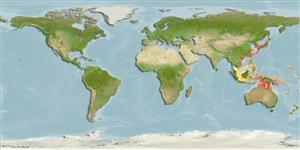Environment: milieu / climate zone / depth range / distribution range
Ecology
Marine; demersal; depth range 15 - 50 m (Ref. 559). Temperate
Western Pacific: Korea, Japan, Taiwan, and New Caledonia.
Size / Weight / Age
Maturity: Lm ? range ? - ? cm
Max length : 13.0 cm SL male/unsexed; (Ref. 559); 10.0 cm SL (female)
Occurs in large schools in rocky areas.
Life cycle and mating behavior
Maturities | Reproduction | Spawnings | Egg(s) | Fecundities | Larvae
Heemstra, P.C. and J.E. Randall, 1979. A revision of the anthiine fish genus Sacura (Perciformes: Serranidae) with descriptions of two new species. J.L.B. Smith Inst. Ichthyol. Spec. Publ. 20:12 p. (Ref. 11311)
IUCN Red List Status (Ref. 130435)
Threat to humans
Harmless
Human uses
Tools
Special reports
Download XML
Internet sources
Estimates based on models
Preferred temperature (Ref.
123201): 16.8 - 27.8, mean 25 °C (based on 86 cells).
Phylogenetic diversity index (Ref.
82804): PD
50 = 0.5625 [Uniqueness, from 0.5 = low to 2.0 = high].
Trophic level (Ref.
69278): 3.4 ±0.45 se; based on food items.
Resilience (Ref.
120179): High, minimum population doubling time less than 15 months (Preliminary K or Fecundity.).
Fishing Vulnerability (Ref.
59153): Low vulnerability (10 of 100).
